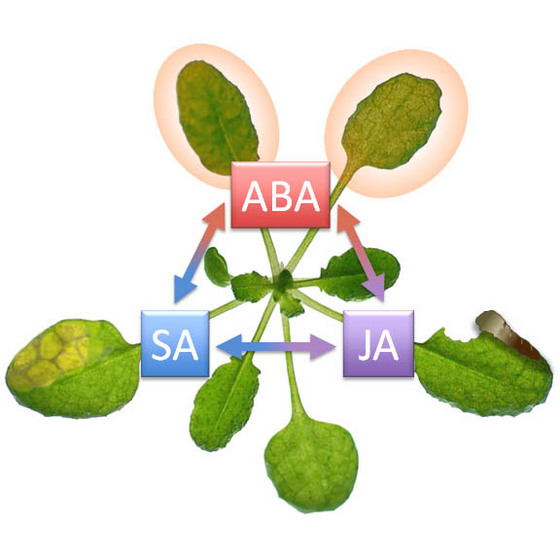Plant hormones interplay: salicylic, jasmonic and abscisic acids
The word "hormone" comes from the Greek word meaning "set in motion". The hormones are signal molecules produced within the living organism, and occur in extremely low concentrations. Plant hormones affect gene expression and transcription levels, cellular division, and growth. They regulate cellular processes in designated cells locally and in other locations within the plant. Plants, unlike animals, lack glands that produce and secrete hormones. Instead, each cell is capable of producing hormones. They affect which tissues grow upward and which grow downward, leaf formation and stem growth, fruit development and ripening, plant longevity, and even plant death.
The plant hormone abscisic acid (ABA, BMRB entry bmse001238) belongs to a chemical class of metabolites known as isoprenoids, also called terpenoids. ABA is a substance that appeared to be involved primarily in seed maturation, stress responses, and in regulating closure of leaf pores (stomata). In leaves, abscisic acid is produced in large amounts when the plant lacks sufficient water, promoting closure of stomata and hence reducing further water losses. Similarly, levels of abscisic acid increase suddenly in response to heating, waterlogging, and chilling. It was formerly believed to play a role in abscission: plants dropping a leaf, fruit, flower, or seed; hence the name.
ABA also functions in response to all environmental stresses through its ability to induce expression of specific genes. Thus, ABA has been called a stress hormone, and its health benefits for humans have recently come to light. It was shown that abscisic acid affects the expression of several genes involved in inflammation, metabolism and cell signaling, which is applicable in the treatment of inflammatory and immune-mediated diseases. Scientists have uncovered the mechanism by which the plant hormone abscisic acid interacts with peroxisome proliferator-activated receptor-gamma, including the involvement of a specific molecule found on the surface of immune cells involved in the body's fight against infection, to block inflammation and the subsequent onset of disease [1].
Along with other effects, ABA is known to stimulate insulin release through pancreatic cells and to increase sensitivity of fat cells to insulin, which makes it a potent weapon against metabolic syndrome and diabetes. It has recently been reported that maple syrup contains polyphenols and equally important quantities of terpenes, and in particular, abscisic acid. Abscisic acid in maple water and maple syrup occurs as a conjugate along with certain metabolites at concentrations that are therapeutic.
Recently it was discovered that ABA is produced by a wide range of animals, including sponges and jellyfish, by human parasites and, significantly, by various mammalian tissues and cells (leukocytes and pancreatic cells). ABA is a universal signaling molecule that stimulates diverse functions in animals through a signaling pathway that is remarkably similar to that used by plants. Thus, it stimulates the stress response to heat and light in animal cells, immune responses in leukocytes, insulin release from pancreatic cells, and the expansion of mesenchymal and colon stem cells. ABA also inhibits the growth and induces the differentiation of cancer cells. Unlike some drugs that act as cell killers, ABA, when functioning as a growth regulator, does not have significant toxic side effects on animal cells. Research has indicated that ABA is an endogenous immune regulator in animals and has potential medicinal applications for several human diseases [2].

Another common plant hormone: salicylic acid (SA) activates genes in some plants that produce chemicals empowering defense against pathogenic invaders. SA is involved in endogenous signaling, mediating in plant defense against pathogens. It also plays roles in plant growth and development, photosynthesis, transpiration, ion uptake and transport.
The first evidence that SA is a plant hormone came from studies of voodoo lily. During blooming, the voodoo lily inflorescence exhibits two episodes of thermogenesis (heat production). These events increase the surface temperature of the inflorescence and are thought to volatilize pheromone compounds that attract/stimulate insect pollinators. Scientists uncovered that externally supplied SA and two closely related analogs also induced heat production. The findings also suggests a strong interconnection between flowering and enhanced disease resistance.
Biochemically, salicylic acid SA activates adenosine monophosphate-activated protein kinase (AMPK) and this action may play a role in the anticancer effects of the compound and its prodrugs aspirin and salsalate that have been recently suggested. The observed antidiabetic effects of SA are likely mediated by AMPK activation primarily through allosteric conformational change that increases levels of phosphorylation.
SA occurs in plants as free salicylic acid and its carboxylated esters and phenolic glycosides. Several studies suggest that humans metabolize salicylic acid in measurable quantities from these plants. Dietary salicylic acid may be partially responsible for the health benefits of a plant-based diet. Traditional medicines made from willow and other salicylate-rich plants are mentioned in clay tablets from ancient Sumer as well as the Ebers Papyrus from ancient Egypt; Hippocrates referred to their use of salicylic tea to reduce fevers around 400 BC. And of course they were part of the pharmacopoeia of Western medicine in classical antiquity and the Middle Ages.
Studies suggested that SA is synthesized endogenously in humans using benzoic acid as a precursor. Given the myriad effects of SA’s prodrug aspirin, others have speculated that SA is a critical animal bio-regulator that plays a key role in orchestrating defense responses, analogous to its role in plants [3].

While salicylic acid acts as a potent agent against biotic stress, another plant hormone: jasmonic acid (JA), produced from fatty acids, also seem to promote the production of defense proteins that are used to fend off invading organisms. Plants that come under attack by insects or damaged mechanically, produce higher levels of JA and its derivative methyl jasmonate, which build up in the damaged parts of the plant. Jasmonates are also controlling temperature stress tolerance of various crops. They play essential roles in mediating plant physiology and alleviating various environmental perturbations.
It was discovered that the JA known as a signalling molecule, not only regulates flower development in the bud stage, but also triggers nectar production in some plants. This particular nectar, produced by special glands called "extrafloral nectaries," has nothing to do with pollination, but attracts ants to the herbivore-attacked plants. And the ants act as defenders against the pests. The sugars in the nectar reward the ants for defending the plant.
In the plants kingdom, herbivorous pests often turn on each other when their food is of poor quality or limited in supply. Some plants are known to affect the behaviour of their pests by making them more predatory towards other species. Integrative biologists at the University of Wisconsin in Madison triggered a defensive reaction in tomato plants (Solanum lycopersicum) by exposing them to various amounts of methyl jasmonate (MeJA) that plants release to alert each other to danger from pests. When cued with MeJA, tomato plants respond by producing toxins that make them less nutritious to insects. Further research showed that plants more strongly cued with MeJA had lost less biomass compared with control plants or with ones that had received a weaker induction. This proved that the reaction was somehow effective at protecting the plants.
Next, the team wanted to test whether the plants’ response was triggering cannibalistic behaviour in caterpillars: natural tomato eaters. The team observed that caterpillars fed with leaves from the tomato plants treated with jasmonates had turned onto their own dead larvae earlier, and had eaten more of them. Thus, the plants can induce pests to eat each other ealier than usual, or expected, with more of the plant left undamaged as a result [4].
When plants are in combat with environmental stress factors they are less able to battle invading pathogens, as research showed. Survival depends on the ability to resist not only disease but also changes in the environment. A mechanism known as systemic acquired resistance (SAR) is used against biotic threats (bacteria, viruses and fungi); that mecahismm involves SA and JA/MeJA. The plants' reactions to abiotic stressors (temperature, drought and salinity) are governed by a different system that is influenced in part by ABA. In the process phytohormones are interconnected with each other and adjust plant development and responses.

It was proposed that a three-sided antagonistic interaction between abscissic acid (ABA) and two other plant hormones: salicyclic acid (SA) and jasmonic acid (JA), controls the response to external abiotic and biotic stresses [5]. The reserchers note that this antagonistic crosstalk would be useful in nature because reactions to both disease and environmental stress require significant amounts of energy for gene expression and metabolic changes, and plants need to regulate the amount of resources given to each reaction to survive.
Plant stress hormones activate cellular responses, including cell death, to diverse stress situations in plants. Researchers have found that some plant stress hormones share the ability to adversely affect human cancer cells. For example, sodium salicylate has been found to suppress proliferation of lymphoblastic leukemia, prostate, breast, and melanoma human cancer cells. Jasmonic acid induced death in lymphoblastic leukemia cells. Methyl jasmonate also has been found to induce cell death in a number of cancer cell lines. Abscisic acid has beneficial effects on several conditions and diseases including inflammation, diabetes and atherosclerosis. Integrating new findings on application of plant hormones in treatment of various animal deseases, general models on networks, functions and regulation, are widely discussed and presented in recent literature. Recent studies have indicated that these hormones show antiviral, antifungal, antiproliferative, antibacterial, neuroprotective and immunomodulatory properties in animal systems.
Nuclear Magnetic Resonance (NMR) spectroscopy is routinely used as a technique to provide insight into metabolic processes in living organisms. The metabolomics database at the BMRB contains 1H, 13C, 13CDEPT90, DEPT135, TOCSY, COSY45, HSQC, HMBC and HSQC-TOCSY-ADIA NMR spectral data for various plant hormones presented as time domain data. The spectra pictures as well as the tables of peak transitions and assigned chemical shifts are also available. The data is available for the abscissic acid (BMRB entry bmse001238) and jasmonic acid (BMRB entry bmse000525) derivatives as well as other plant metabolites.
[1] Virginia Tech. "How natural drug, abscisic acid, fights inflammation." ScienceDaily. www.sciencedaily.com/releases/2010/12/101209152748.htm (accessed November 30, 2018).
[2] Hai-Hang Li, Rui-Lin Hao, Shan-Shan Wu, Peng-Cheng Guo, Chang-Jian Chen, Li-Ping Pan, He Ni, "Occurrence, function and potential medicinal applications of the phytohormone abscisic acid in animals and humans", Biochemical Pharmacology 82(7) (2011) 701–712.
[3] D’Maris Amick Dempsey and Daniel F. Klessig, "How does the multifaceted plant hormone salicylic acid combat disease in plants and are similar mechanisms utilized in humans?", BMC Biology 2017 15:23 (doi:10.1186/s12915-017-0364-8)
[4] John Orrock, Brian Connolly, and Anthony Kitchen, "Induced defences in plants reduce herbivory by increasing cannibalism", Nature Ecology & Evolution 2017 1:1205-1207 (doi:10.1038/s41559-017-0231-6)
[5] Yasuda, M., Ishikawa, A., Jikumaru, Y., Seki, M., Umezawa, T., Asami, T., Maruyama-Nakashita, A., Kudo, T., Shinozaki, K., Yoshida, S. & Nakashita, H., "Antagonistic interaction between systemic acquired resistance and the abscisic acid-mediated abiotic stress response in Arabidopsis", The Plant Cell 2008, 20(6): 1678–1692 (doi:10.1105/tpc.107.054296)
